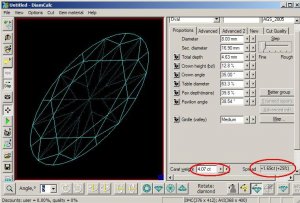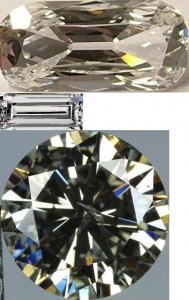- Joined
- Aug 15, 2000
- Messages
- 19,186
Send me or upload a .srn or .gem or .dmc 3D scan file of the stone and DiamCalc calculates it.Date: 5/9/2009 2:40:22 AM
Author: DiaGem
Ok..., how would a consumer or even a pro like you calculate the value of this Cushion based on your ''$''s per sq. mm.'' compared to round brilliant?Date: 5/8/2009 7:07:08 PM
Author: Garry H (Cut Nut)
DiaGem if you do inhouse searches here on Pricescope for rounds, princess radiant and asscher you will find spread information on the right side of the page - Lt and I choose not to do curvy shapes because there can be too much variability.Date: 5/8/2009 9:57:54 AM
Author: DiaGem
I think you will need to describe it a bit more...Date: 5/8/2009 6:27:51 AM
Author: Garry H (Cut Nut)
You are on the money Dave, but if I can have a moment of rare disagreement with you (sort of)
The rough is there - why consumer electricity and fossil fuels to remove it it if does not negatively influence the beauty?
There are plenty of people who can afford a 1ct cushion who will enjoy the naming rights (as per a post/arguement by Jim Schultz a couple years back).
The only isue as I read / see it is that peole should pay for what they get (with a small prestige magic weight premium perhaps?).
In Next Diamond and all the Cut Groups approaches we see the simple solution as listing the carat weight and alongside it - the spread relative to a 6.47mm 1ct round.
We instituted it here on Pricescope many years ago on advanced inhouse etc searches.
So if a stone is 1.00ct with -20% beside it, or if Labs would do as I hope we can in ND - we will simply describe the diamond as 1.00ct (0.80ct -20% spread). Then the buyer can make their own informed choice.
Or are you talking about rounds only? Cause if you are talking about comparing relative spreads of Cushion Cuts..., I am eager to read... ....
....
But Diamcalc does it for any shape and so it wil be a breeze for Next Diamond.
We strongly believe consumers should compare every cut to ROUND.
Why, because the prices of diamonds generally line up pretty well to $''s per square millimeter.
Unit pricing is a standar in the world today - in supermarkets, pharmacys and drug stores etc. Buyers have it as a right!
It is easy to compare cushion to cushion with the round spread. And gives more information. It also overcomes the playing King Solomon role that AGSL find themselves in - if the make the zero too low the cutters never send them stones. Each lab would establish their own rule = even more confusion and opacity for consumers.
Its a:
Weight: 4.0X carat
Dimensions:16.90x8.00x4.50mm.
it will be an intrinsic part of Next Diamond and any lab in the world can do it now for a few hundred dollars.







300x240.png)